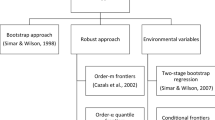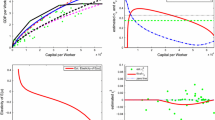Abstract
The iterated bootstrap may be used to estimate errors which arise from a single pass of the bootstrap and thereby to correct for them. Here the iteration is employed to correct for coverage probability of confidence intervals obtained by a percentile method in the context of production frontier estimation with panel data. The parameter of interest is the maximum of the intercepts in a fixed firm effect model. The bootstrap distribution estimators are consistent if and only if there are no ties for this maximum. In the regular case (no ties), poor distribution estimators can result when the second largest intercept is close to the maximum. The iterated bootstrap is thus suggested to improve the accuracy of the obtained distributions. The result is illustrated in the analysis of labor efficiency of railway companies.
Similar content being viewed by others
References
Beran, R. (1987). “Prepivoting to reduce level error of confidence sets.”Biometrika 74, 457–468.
Davison, A.C., Hinkley, D.V., and Schechtman. (1986). “Efficient bootstrap simulation.”Biometrika 73, 555–566.
Farrell, M.J. (1957). “The measurement of production efficiency.”Journal of the Royal Statistical Society A 120, 253–281.
Gathon, H.J. and S. Perelman. (1990). “Measuring technical efficiency in national railways: A panel data approach.” Mimeo, Université de Liège, Belgium.
Gleason, J.R. (1988). “Algorithms for balanced bootstrap simulations.”American Statisticians 42, 263–266.
Hall, P. (1986). “On the bootstrap and confidence intervals.”Annals of Statistics 14, 1431–1452.
Hall, P. (1992).The Bootstrap and Edgeworth Expansion, New York/Berlin: Springer-Verlag.
Hall, P., Härdle, W., and L. Simar. (1993). “On the inconsistency of bootstrap distribution estimators.”Computational Statistics and Data Analysis 16, 11–18.
Hall, P. and M.A. Martin. (1988). “On bootstrap resampling and iteration.”Biometrika 75, 661–671.
Loh, W.-Y. (1987). “Calibrating confidence coefficients.”Journal of the American Statistical Association 82, 155–162.
Schmidt, P. and R.E. Sickles. (1984). “Production frontiers and panel data.”Journal of Business and Economic Statistics 2, 367–374.
Simar, L. (1992). “Estimating efficiencies from frontier models with panel data: A comparison of parametric, nonparametric and semiparametric methods with bootstrapping.”The Journal of Productivity Analysis 3, 171–203.
U.I.C. (1970–1983).Statistiques Internationales des Chemins de Fer, Union Internationale des Chemins de Fer, Paris.
Author information
Authors and Affiliations
Additional information
This work was supported in part by grant No. 26 from the program “Pôle d'attraction interuniversitaire-Deuxième phase” to CORE and by the contract “Projet d'Actions de Recherche Concertées of the Belgian governement” (PARC) to the Institute of Statistics, Université Catholique de Louvain. The first author was partly financed by the Institut de Mathématiques Appliquées, Université Catholique de Louvain.
Rights and permissions
About this article
Cite this article
Hall, P., Härdle, W. & Simar, L. Iterated bootstrap with applications to frontier models. J Prod Anal 6, 63–76 (1995). https://doi.org/10.1007/BF01073495
Issue Date:
DOI: https://doi.org/10.1007/BF01073495




